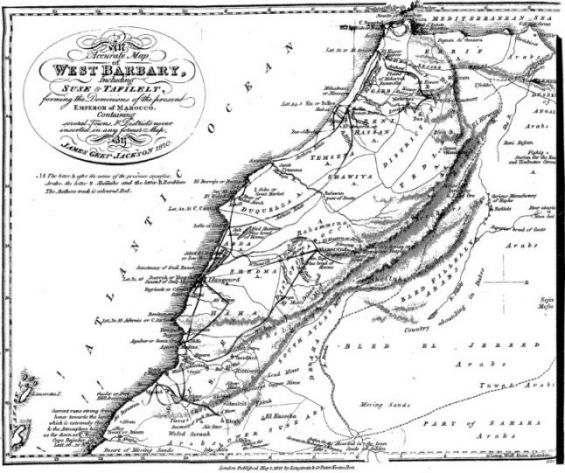After spending 9 years trying to befriend the United States of America, Sultan Moulay Mohammed III (1710-1790) managed to sign a Treaty of Friendship in Marrakech formalizing relations with the country. Since then, the Kingdom of Morocco and the Alaouite sultans that succeeded, Moulay Mohammed III, remained in good terms with the American nation strengthening throughout the years their bilateral ties.
The Treaty of Marrakech was a turning point in the history of the two nations and was considered the first of its kind between the USA and an Arab, Muslim and African country. Following the long-awaited pact, according to data provided by the USA Embassy, President George Washington wrote to Sultan Mohammed III on the 1st of December 1789 calling him a «great and magnanimous friend». Realizing the importance of the American-Moroccan friendship, Washington sent the letter to inform the Sultan about the USA’s new constitution.
After the Treaty of Marrakech
«It gives me pleasure to have this opportunity of assuring your majesty that shall not cease to promote every measure that may conduce to the friendship and harmony which so happily subsist between your empire and these», the President wrote. As the country has just gained its independence, George Washington was in the need of the North African Kingdom’s friendship, he indicated : «within our territories, there are no mines of either gold or of silver, and this young nation, just recovering from the waste and desolation of a long war, has not, as yet, had time to acquire riches by agriculture and commerce».
 George Washington's letter to Sultan Moulay Mohammed III./Ph. DR
George Washington's letter to Sultan Moulay Mohammed III./Ph. DR
George Washington’s words were well received by the 79-year-old Sultan, who respected the terms and conditions of the treaty granting a special status to American ships and allowing trade with them. However, after Sultan Mohammed II death in 1790, President Washington and his Secretary of State Thomas Jefferson were afraid that his death would do harm to the treaty. Succeeded by his son, Moulay Yazid, ruled only for two years, and then by his other son Moulay Suliman (ruled between 1792-1822) who followed his father’s steps when it comes to the Kingdom’s foreign affairs.
What after the death of Sultan Mohammed III ?
«The friendship of this power is important because our Atlantic as well as Mediterranean trade is open to his annoyances and because we carry on useful commerce with his nation», Thomas Jefferson told the congress. Consequently, Thomas Barclay, the former American consul in Paris who was set to negotiate the Marrakech Treaty a few years before, was given the title of consul, but unfortunately died on his way to Morocco. James Simpson, the consul at Giblartar, was assigned to meet Sultan Suliman to reaffirm Morocco’s commitment regarding the treaty.
Fortunately, Sultan Suliman was happy to reassure the Americans writing a letter to President Washington. «…we are at peace, tranquility and friendship with you in the same manner as you were with our father who is in glory. Peace», Sultan Suliman wrote adding that «…the Americans, I find, are the Christian nation my father most esteemed … I am the same with them as my father was and I trust they will be so with me».
 The Tangier American legation./Ph. DR
The Tangier American legation./Ph. DR
With the both sides reassured, Simpson was appointed consul to Morocco in Tangier in 1797. In 1821, Sultan Moulay Suliman offered a house to the USA as a residence (known as the Tangier American Legation) of the American Consul General, John Mullowny. Relations were further reinforced between Morocco and the US, under the rein of Moulay Suliman. This was confirmed through a letter sent to Mullowny «… I order and permit free trade with all Americans in any part of my empire … the Americans mean more to me than any other nation, and whatever footing the most favored nation is on, they are to be favored more than any other.»
Renewing the Treaty
In 1835, 49 years after the signing of the Marrakech Treaty which was about to expire, Andrew Jackson, the 7th US President, ordered James R. Leib to discuss renewing the treaty with Sultan Abderrahman (ruled from 1822-1859), Sultan Suliman’s son and successor. The latter gave the Treaty an indefinitely effect, it was signed in Mekness on 16th of September 1836 after a smooth negotiation with the Sultan. The treaty was later endorsed in Tangier on October 1st 1836 and proclaimed on January 30th 1837.
 DR
DR
Morocco’s support to the USA was carried out later even during the Civil War. Through thick and thin, the Moroccan Minister of Foreign Affairs assured the American consul, Jesse H. McMath, that his country is «being a sincere friend of the American nation would never air or give countenance to the insurgents».
From 1777 and throughout the rest of the 18th and beginning of the 19th century, Morocco and the USA managed to strengthen their diplomatic relations and draw a broad line in their history following the initiative set by Sultan Mohammed III.





 chargement...
chargement...













